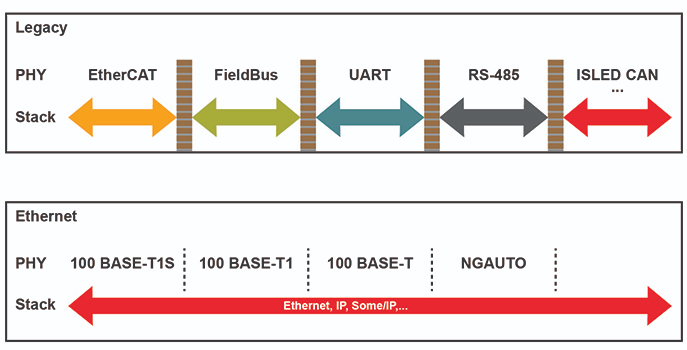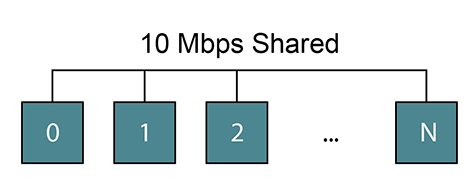By Microchip Joe Bush
Networks based on Ethernet and Internet Protocol (IP) are ubiquitous. You can find them in standard computer networks as well as in cars, IoT and various automation applications, and they have been around for nearly 50 years. Henry Muyshondt, senior manager at Microchip Technology, explains.
Ethernet provides scalable bandwidth, from a few megabits per second to several gigabits per second, over several different physical media, and proven software stacks are available to ensure reliable transmission over the media.
Security is an essential element of this technology and there is a well-defined framework for its inclusion in Ethernet-based systems.
Ethernet's service-oriented architecture helps to do the work of complexity through packet functions and data management. Many systems can easily communicate with each other by reusing unified communication mechanisms, and allow services to be easily moved to the appropriate location in the network.
In the past, many different technology protocols have been used to interconnect different devices. In the industrial automation world, there are various fieldbuses, Ethercat, RS-485, UART, etc. In the automotive world, MOST, CAN, LIN and other networks are used, requiring complex gateway devices to communicate between domains. In the computer server market, we see I2C, GPIO, SPI and even CAN from the automotive world used to manage various subsystems.

Figure 1. Illustrated is the advantage of Ethernet architecture coherence
Each of these uses its own hardware interface and implements a different software stack. EMC behavior varies. An all-Ethernet architecture has many advantages because the same protocol can be used regardless of the physical layer. An Ethernet frame looks the same whether it is transmitted at 10Mbit/s or 10Gbit/s.
When bandwidth is extended for a specific application, no complex gateway is required. Typically, a single switch can be equipped with PHY chips running at different speeds, and frames can be seamlessly moved from one domain to another without modifying the data.
The ubiquitous Ethernet architecture simplifies the design, configuration, and control of many different applications in the industrial, computer, or automotive sectors. The same technical expertise can be used in different markets. No matter how much data needs to be transmitted, the same mechanism can be used because the Ethernet frame is not modified for different speed grades. In addition, there is a large ecosystem of hardware and software suppliers for Ethernet communication infrastructure.
The Ethernet world has designed architectures to ensure the security and privacy of information transmitted over Ethernet links, and this security infrastructure is well known.
10BASE-T1S—The New IEEE Standard
The IEEE has developed a new variation of the Ethernet standard that provides 10Mbit/s bandwidth over a single-pair physical layer. The specification is called IEEE Std 802.3cg-2019. The details are already finalized and the specification should be published in early 2020. The specification extends the range of modern Ethernet physical layers at the lower end of the bandwidth range.
One variant specified by the IEEE standard is called 10BASE-T1S. The S stands for short reach, and a long reach variant called 10BASE-T1L is also defined, which has a maximum reach of 1 km. This article focuses on 10BASE-T1S.
10BASE-T1S uses a multi-point topology where each node is connected using a single cable. This eliminates the need for switches and reduces the number of cables. Each cable uses only one pair of wires, rather than the four pairs used in typical Ethernet cables, and the interconnect can even be implemented on a printed circuit board. The standard specifies that a minimum of eight nodes can be connected, but more can be connected. It also specifies a bus length of 25m, with a 10cm stub for each node. All nodes share the 10Mb/s bandwidth.

Figure 2 shows the concept of a shared bus.
The standard also specifies an arbitration scheme called physical layer collision avoidance (PLCA) that makes the best use of available bandwidth while reducing latency and improving quality of service (QoS).
Microchip has been a major contributor to the IEEE standards process, supporting it with not only chips but also application boards and the tools needed to emulate, implement and analyze network systems.
Physical Layer Collision Avoidance (PLCA) Details
After PLCA is started, only PHY devices that have a transmission opportunity are allowed to send data. Transmission opportunities are allocated in a round-robin manner. Each PHY can transmit during its transmission opportunity and can then send an information frame. A new cycle begins when the master node sends a beacon. Figure 3 illustrates the process.
In practice, round-trip delays between two nodes have been observed to be less than half a millisecond, and almost the full speed of 10Mbit/s is obtained when using the iperf3 tool for measuring the maximum achievable bandwidth on IP networks.
Application Areas
10BASE-T1S technology is gaining traction in building/industrial automation, automotive, and computer applications.
In industrial applications, this interconnect scheme has been deployed in many applications to provide in-system management and connect many devices such as fans, temperature sensors, voltage monitors, etc. Even simple devices such as switches, buttons, indicator lights, etc. can be addressed using the Ethernet scheme.
In automobiles, various sensors require lower bandwidth and benefit from a network architecture that makes the subsystems more scalable to accommodate different vehicle deployments.

Figure 3. A new cycle starts when the master sends a beacon
In the computing world, 10BASE-T1S is required for in-system management interfaces inside servers and switches, as well as for applications used to configure and monitor large servers. Similarly in the industrial world, Ethernet can be used to easily access a variety of devices such as fans, temperature sensors, and voltage monitors.
Although the transmission of power over data lines (PoDL) has not yet been fully standardized, there are some working groups working on it, and the IEEE is extending the 802.3cg specification to include PoDL. The 10BASE-T1S physical layer is AC-coupled so that it can power remote devices.
in conclusion
10BASE-T1S has the following key features that extend Ethernet technology to new applications:
Multipoint Physical Layer
No Conflict
Efficient bandwidth utilization
Determinism and low latency
Security Mechanism
The ubiquitous Ethernet architecture simplifies the design, configuration and control of many different applications in the industrial, computer or automotive fields.
10BASE-T1S components are commercially available and are already being implemented in new system designs.
Previous article:New Ixxat Smart Grid Gateway from HMS Networks enables remote access
Next article:Würth Elektronik launches BLE 5.1 module for more secure wireless connections
- Popular Resources
- Popular amplifiers
- Infineon Technologies Launches ModusToolbox™ Motor Kit to Simplify Motor Control Development
- STMicroelectronics IO-Link Actuator Board Brings Turnkey Reference Design to Industrial Monitoring and Equipment Manufacturers
- SABIC further deepens strategic partnership with Boao Forum for Asia
- Using 3.3V CAN transceivers to achieve reliable data transmission in industrial systems
- Nidec Precision Testing Technology will be exhibited at SEMICON Japan 2024
- HARTING and TTI announce strategic partnership now extended to Asia
- Samtec Connector Science | Connecting Artificial Intelligence in Smart Factories
- Advantech and Innodisk collaborate to unlock AMR vision capabilities with AFE-R360 MIPI camera module
- Laird Thermal Systems Announces New Line of Micro-Thermoelectric Coolers for Next-Generation Optoelectronic Devices
- Intel promotes AI with multi-dimensional efforts in technology, application, and ecology
- ChinaJoy Qualcomm Snapdragon Theme Pavilion takes you to experience the new changes in digital entertainment in the 5G era
- Infineon's latest generation IGBT technology platform enables precise control of speed and position
- Two test methods for LED lighting life
- Don't Let Lightning Induced Surges Scare You
- Application of brushless motor controller ML4425/4426
- Easy identification of LED power supply quality
- World's first integrated photovoltaic solar system completed in Israel
- Sliding window mean filter for avr microcontroller AD conversion
- What does call mean in the detailed explanation of ABB robot programming instructions?
- STMicroelectronics discloses its 2027-2028 financial model and path to achieve its 2030 goals
- 2024 China Automotive Charging and Battery Swapping Ecosystem Conference held in Taiyuan
- State-owned enterprises team up to invest in solid-state battery giant
- The evolution of electronic and electrical architecture is accelerating
- The first! National Automotive Chip Quality Inspection Center established
- BYD releases self-developed automotive chip using 4nm process, with a running score of up to 1.15 million
- GEODNET launches GEO-PULSE, a car GPS navigation device
- Should Chinese car companies develop their own high-computing chips?
- Infineon and Siemens combine embedded automotive software platform with microcontrollers to provide the necessary functions for next-generation SDVs
- Continental launches invisible biometric sensor display to monitor passengers' vital signs
- EEWORLD University ---- Simplelink Academy: Introduction to Sensor Controller
- Hiring embedded engineers
- Does the clock signal return groove have anything to do with the test point location?
- Practical RF training course sharing 1
- NUCLEO-L4R5 CubeMX generated USB CDC cannot be recognized solution
- FPGA Implementation of ECT Image Reconstruction Algorithm
- A brief history of the development of oscilloscopes
- Programming of receiving and sending data via the serial port of a single-chip microcomputer
- [LPC8N04 Evaluation] 4. Lighting up the LED and questions
- MSP430 MCU UART_FIFO send and receive

 LTC6252HS6#TRMPBF
LTC6252HS6#TRMPBF











 京公网安备 11010802033920号
京公网安备 11010802033920号